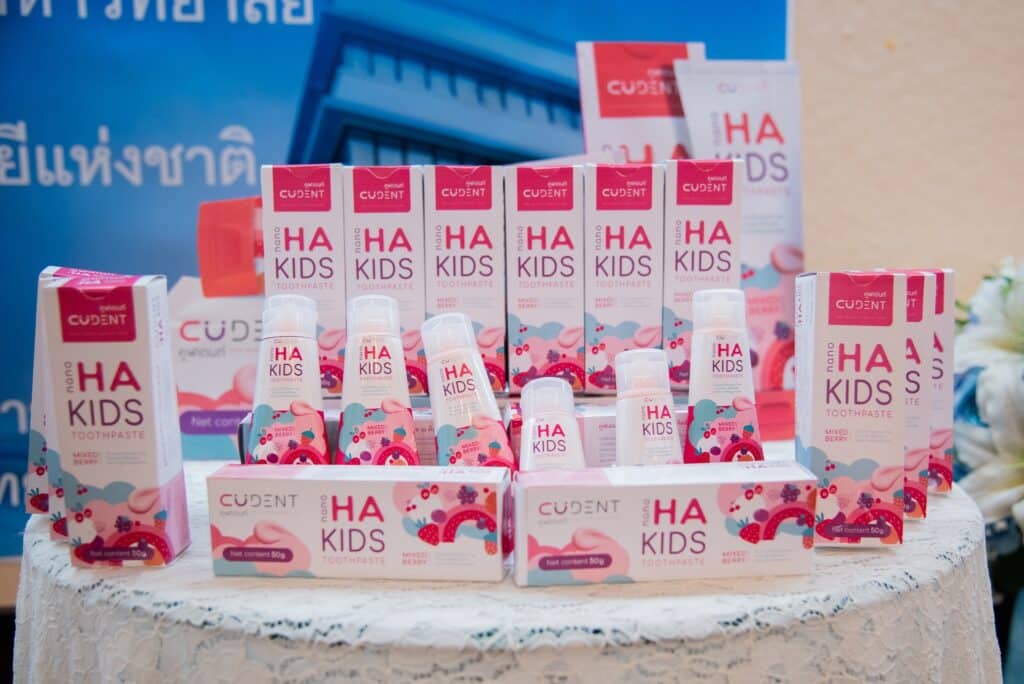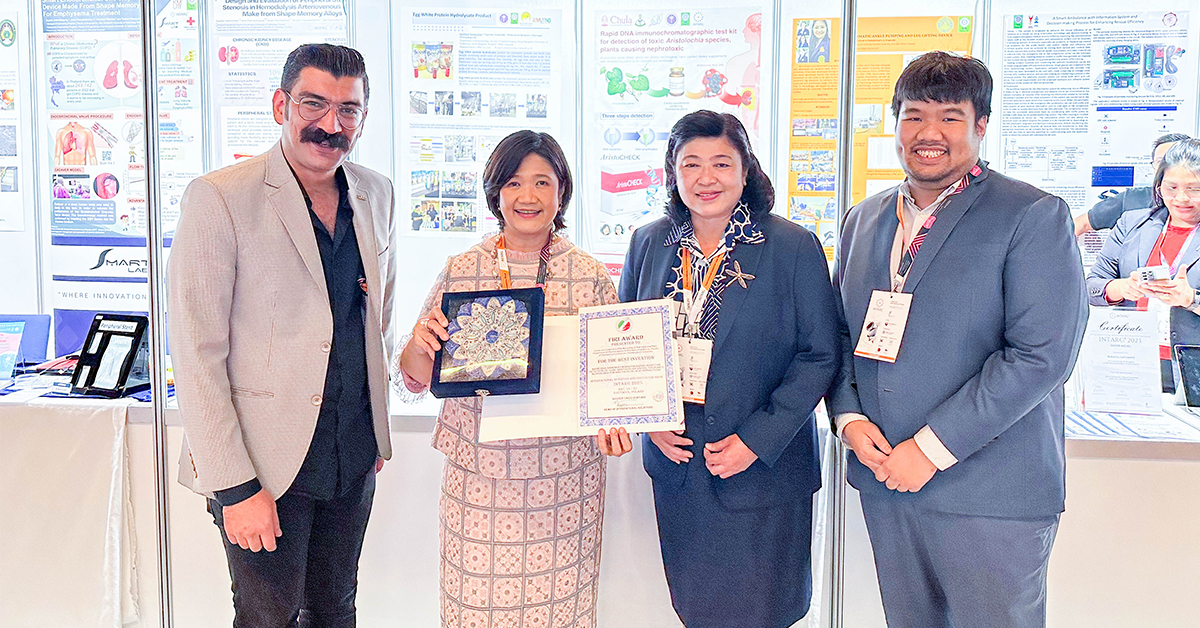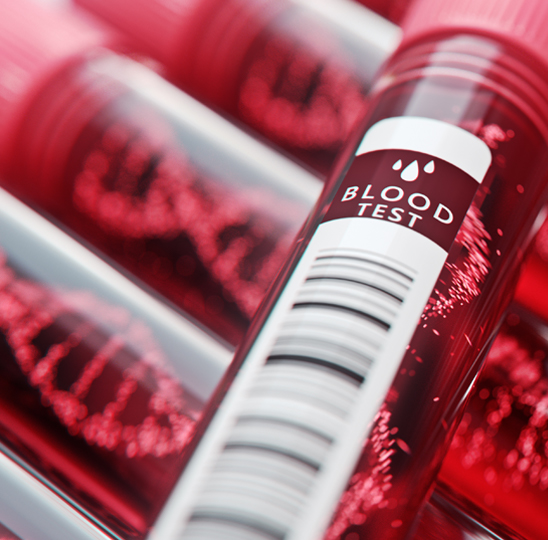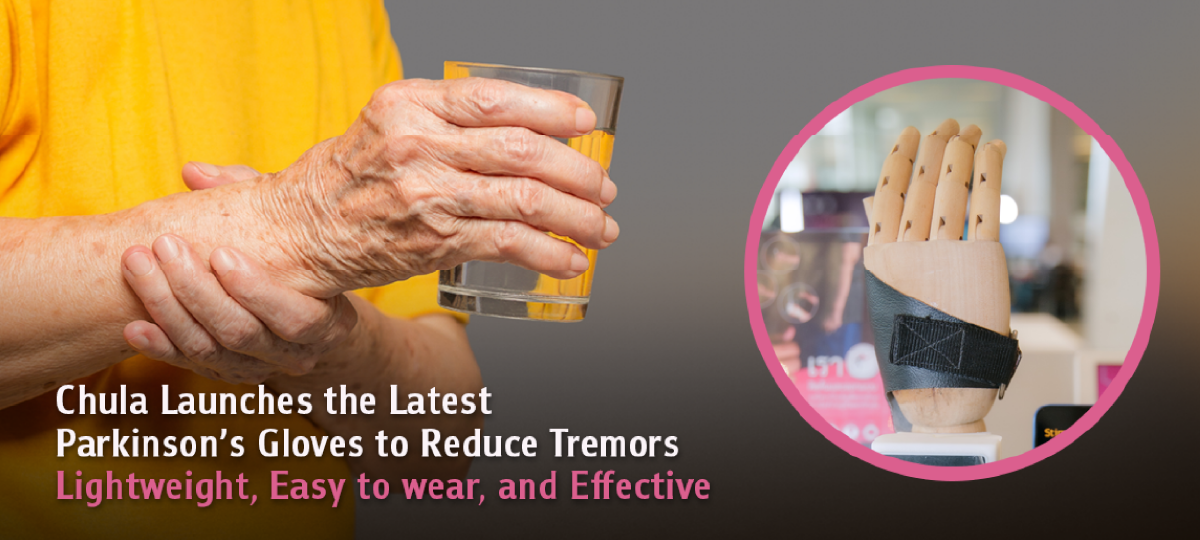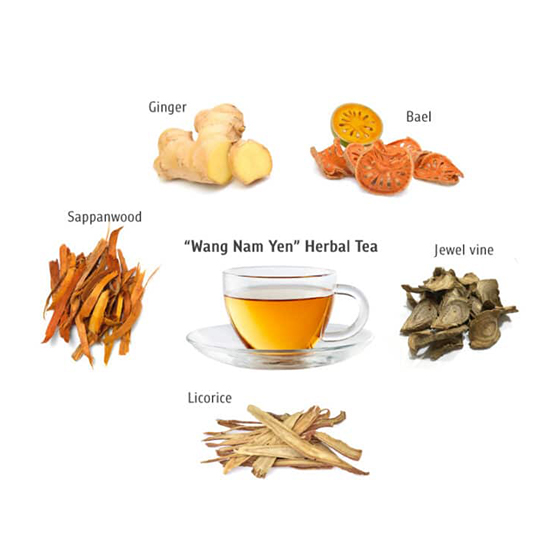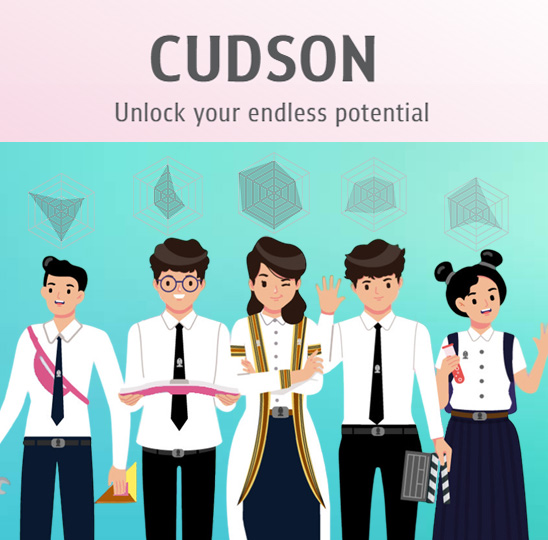Chula Veterinary Science Lecturers have successfully developed a Serum Test Kit to Identify Canine Atopic Dermatitis (CAD) caused by dust mites. With a Gold Medal from the Swiss Innovation Contest, the test kit is guaranteed to help identify the allergens with greater precision to ensure correct treatment.
Atopic dermatitis is one of the most common allergies in dogs, with prominent symptoms such as itching, erythema, and severe swelling. In severe cases, there can be symptoms of bronchospasm, coughing, and sneezing like people with allergies.
Itching and erythema in dogs are not to be overlooked. Dog owners should pay attention and take their pets to be examined and receive appropriate and spot-on care, which can only be done if the cause or culprit of the skin allergy can be identified.
Screening for skin allergy in dogs is quite limited, complex, time-consuming, and very costly. Associate Professor Dr. Nuvee Prapasarakul, Department of Microbiology, Faculty of Veterinary Science, Chulalongkorn University, and a team of researchers, consisting of Dr. Nathrada Khanthawee, Associate Professor Dr. Nitat Sookrung, Miss Nawannaporn Lim, and Assistant Professor Dr. Wandee Sirichokchatchawan, therefore, invented and developed “a Serum Test Kit to Identify Canine Atopic Dermatitis (CAD) caused by dust mite using Immunoglobulin G1 (G subclass one) to help veterinarians identify the cause of allergy in dogs more quickly and easily.
“This test kit can be used continuously from the start of allergy testing, during symptom monitoring until the end of treatment without the dog getting hurt, and it can also be cost-effective,” said Assoc. Prof. Dr. Nuvee about the hallmark of this innovation, which won the gold medal at the 48th International Exhibition of Inventions 2023 held recently in Geneva, the Swiss Confederation.
Getting to Know Canine Atopic Dermatitis (CAD) and Its Causes
Canine Atopic Dermatitis (CAD) is one of the most common forms of skin allergy in dogs, caused by abnormal immune responses to environmental agents such as airborne chemicals, dust, mold, mites, and food.
“Healthy and unhealthy dogs all have the potential to develop this disease. The incidence of skin diseases varies depending on the nature of each dog. Some dog breeds may have frequent skin diseases and severe symptoms, while others may have only minor symptoms and some may not have skin diseases at all,” said Associate Professor Dr. Nuvee.
CAD can be the result of a variety of factors, including:
1. Genetics: Some breeds of dogs are at higher risk than others for AD, including Vizla, Bassett Hound, Yorkshire Terrier, Shih Tzu, Beagle, Bulldog, and Cocker Spaniel. Dogs with weakened immunity or stress are also more prone to skin diseases.
2. Age: Skin allergies in dogs usually start showing symptoms between the ages of 6 months and 3 years old, but symptoms can also occur at any age.
3. Environmental conditions such as dust, dust mites, and high humidity increase the likelihood of developing fungus on the dog’s skin, causing skin irritation and allergies. Cold and dry weather can also dry the dog’s skin, aggravating skin allergies. In hot weather, dogs have more skin problems, which can be a risk factor to develop further skin allergies.
4. Chemicals: Exposure to certain chemicals can be a trigger for skin allergies, especially those used in dog health care products such as soap, shampoo, cream, or some coating substance can all trigger an onset of skin allergy in dogs that are sensitive to these chemicals.
5. Food: Protein from food contributes to around 10-15 percent of skin allergy cases.
However, according to Assoc. Prof. Dr. Nuvee, most skin allergies in dogs are caused by allergens in the environment such as dust mites, pollen, mold, and other substances that dogs come into contact with, especially dust mites which are important factors in triggering allergies.
Atopic Dermatitis Caused by Dust Mites
Dogs with skin allergies from dust mites itch and scratch on the affected skin such as around the ears, abdomen, legs, and under the body. They are plagued with skin eczema, erythema, scarring, or scabby skin on sensitive areas that smell like fermented yeast.
In some cases, the dogs suffering from CAD may experience swelling, redness, and pus in the affected areas. They may have increased hair loss and ulcers caused by scratching or incorrect skin treatment.
Although the majority of canine skin allergies are mainly caused by dust mites, there may be other causes, such as dietary, that may trigger similar symptoms.
How important is allergen identification?
Assoc. Prof. Dr. Nuvee said that identifying allergens is very important to help reduce or avoid them, as well as to help plan for the right treatment, such as the correct administration of anti-allergic medications to reduce the risk of dogs receiving unnecessary or inappropriate treatment.
“Allergies and how to treat them are specific and dependent on each dog and their living environment. A veterinarian specializing in allergies can provide additional counsel on proper handling and allergy prevention for dogs, as well as how to boost their immunity to fight the allergies which helps to somewhat relieve the symptoms. A healthy immunity may strengthen a dog’s tissues and immune system to reduce an abnormal response to something it is allergic to.”
Assoc. Prof. Dr. Nuvee also added that dogs may be allergic to the things being watched for the rest of their lives, or they may develop allergic reactions to something new as well.
Allergen Screening Test Before Planning a Treatment
Allergies in dogs can occur when the dog is 6 months of age or older. Assoc. Prof. Dr. Nuvee recommends that dog owners regularly observe skin symptoms similar to those of skin allergies, such as itching, redness, dampness, thick skin, or dandruff scabs. Should these symptoms occur, you should consult veterinarians specializing in skin diseases or allergies.
“Owners should take note of the dog’s symptoms and response to the environment as information for veterinarians to diagnose and provide appropriate guidance in the management of diseases that may require long-term follow-up treatment to control skin symptoms and disorders.”
Identifying the specific allergens is important in treatment planning. According to Assoc. Prof. Dr. Nuvee, there are currently two test methods:
1. Intradermal skin test is a test under the skin to diagnose airborne allergies. The veterinarian will inject the test substance into the skin layer of the dog and observe the symptoms for some time before evaluating the results according to the dog’s response. The process takes about 1-2 hours.
“There are limitations to this method. Before the dog is tested, all the medications, i.e., anti-inflammatory, anti-itching, immunosuppressant have to be stopped. So, there are risks of the symptoms becoming acute. In addition, this method requires anesthesia, and it is expensive.”
2. Allergen-specific IgE serology testing is a method of detecting airborne allergy symptoms in dogs by measuring the level of Immunoglobulin E (IgE) antibodies produced by the body causing allergic reactions to possible allergens. This test is done on samples of the dog’s blood.
“This method is quite convenient, but not many veterinary laboratories in Thailand provide this service which means they have to send blood samples to foreign laboratories, making it costly, and time consuming. Most importantly, this method requires a substantial amount of blood for the test.”
Scratch where it itches! Innovative Allergen Screening Test Kit with High Precision
Based on the limitations of the two allergen screening tests, Assoc. Prof. Dr. Nuvee, therefore, developed the Serum Test Kit to Identify Canine Atopic Dermatitis (CAD) caused by dust mites using Immunoglobulin G1 (IgG Subclass 1) using a laboratory method called ELISA (Enzyme-Linked Immunosorbent Assay).
Assoc. Prof. Dr. Nuvee explained that “Immunoglobulin G subclass One” is one of the four subclasses of Immunoglobulin G in the immune systems of humans and animals, whose main function is to protect the body from allergies and pathogens. Assessing the level and proportion of each class of Immunoglobulin G can help to diagnose and monitor the immune response to various substances or infections in various forms in the body.
“The research team found that the “immunoglobulin G subclass1” is the primary class of “immunoglobulin G” with a high response rate to allergens in dogs with CAD.”
During the course of the research, Assoc. Prof. Dr. Nuvee tested this test kit on 200 dogs at participating veterinary hospitals throughout Bangkok with satisfactory results, comparable to the effectiveness of the original two methods.
“While we don’t have the best test kit yet, this is an easily accessible method for veterinarians, and it can be used continuously from diagnosis, monitoring, and end-of-treatment without hurting the dogs while being cost-effective,” said Assoc. Prof. Dr. Nuvee. Articles about this innovative serum test kit to identify dust mite allergy in dogs have been published in three Q1 international journals.
Guidelines for the Care and Treatment of CAD
Care and treatment of skin allergies in dogs is a complex process and should be supervised by a veterinarian to ensure proper care for the dogs in each household. Assoc. Prof. Dr. Nuvee summarizes the guidelines for care as follows:
1. Remove allergens – For example, if the dog is allergic to dust, pollen, or dietary protein, the food must be reduced or removed from the dog’s environment as much as possible to reduce exposure and immune response.
2. Feed the dog proper food that does not contain ingredients that can induce dog allergies to reduce the immune response.
3. Use immune-boosting substances such as vitamins and other supplements
“Boosting immunity can help reduce some of the allergies in dogs. A strong immunity can potentially strengthen the dog’s tissues and immune system to reduce abnormal responses to allergens.”
Use medications and medical treatment. In case of severe allergies, the veterinarian may recommend the use of related medications such as steroids, anti-allergy drugs, antifungal drugs, antibiotics, and hair tonics to effectively control allergies. The owner is recommended to administer medication regularly.
Minimize anything that may trigger an allergic reaction, such as washing bed linen, clothing, and household appliances thoroughly. Use mild shampoos to wash the dogs, and focus on general hygiene with proper exercise, proper feeding, and appropriate climate control.
Currently, the Serum Test Kit to Identify Canine Atopic Dermatitis (CAD) caused by dust mites using Immunoglobulin G1 (G subclass one) has already been patented. In the future, Assoc. Prof. Dr. Nuvee intends to develop this innovation into a paper-based, ATK-like test kit for convenience and easy detection of the allergy in one go, while being able to identify other canine allergies in addition to dust mites, such as pollen, food protein allergies, etc.
Moreover, Assoc. Prof. Dr. Nuvee also plans to develop a vaccine, also known as Allergy Immunotherapy or Allergen-Specific Immunotherapy (ASI), as injections to treat allergies accurately!
For more information, contact the Research Department, Faculty of Veterinary Science, Chulalongkorn University, Tel. +66-2218-9440.
For the full release and more images, please visit: https://www.chula.ac.th/en/highlight/125823/




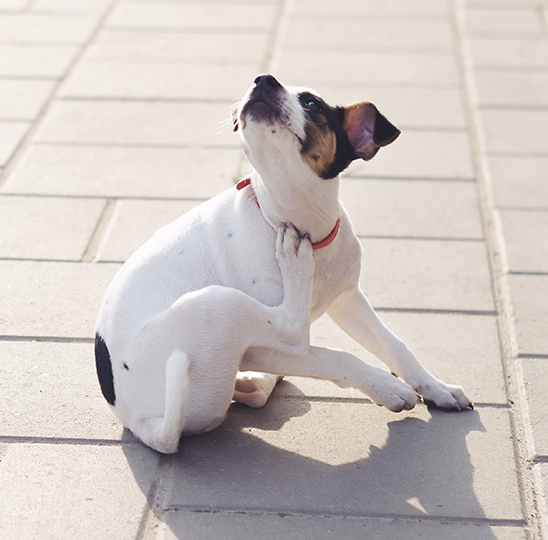
.jpg)
